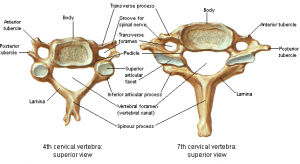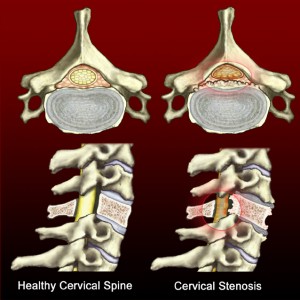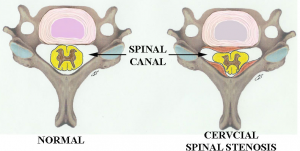The cervical spine has been a topic this week and cervical spinal stenosis is one of many conditions that can trouble the neck.
The spine is made up of twenty-four vertebrae plus the sacrum and tailbone. When we take a look at individual vertebrae they can be split into two, front and back.
The front is the solid, weight bearing body. The back half holds the processes, two transverse and one spinous, and facet joints, that bear responsibility for movement.
When the two halves meet there is a hole between them (foramen) that will form the spinal canal, which the spinal cord passes through when the all the vertebrae of the spine are connected.
Spinal stenosis is a narrowing of the spinal canal that occurs mostly in the cervical (neck) or lumbar (lower back) spine. On rare occasions there can be thoracic (middle back) stenosis.
The effects of cervical spinal stenosis can be felt everywhere in the body, though at the same time you can have cervical spinal stenosis without showing any pain symptoms.
Your spinal canal can narrow, and for whatever reason, not happen to press on any nerves, or the spinal cord, as it happens.
If the narrowing of the canal does compress any of the nerves in the cervical spine the result can be pain, numbness, and/or weakness in the neck, arms, and legs, as well as possibly affecting your bowels and bladder.
There are a number of reasons why someone gets cervical spinal stenosis the most commonly reported is as a natural part of the aging process.
I think it would be better to talk about in the context of poor preparation for the aging process.
A well-aligned skeleton and balanced musculature is essential if we want to avoid, maintain or improve issues with our spine. Everyone benefits from good posture and a solid core.
There is no question that we are drying up from the minute we are born and as we age our bones become more brittle and susceptible to injury.
This is especially so in the spine that has to balance an extremely heavy head on top of it (The spine narrows from bottom to top and, as I wrote the other day, the eight-pound head sits on a four-ounce bone, the atlas).
The amount or the speed with which we desiccate is determined by a number of factors with movement and muscle tone high on the list as mitigating factors of our inevitable decline. Even though there is no avoiding the aging process there are definitely ways to prepare for it.
When it comes to good posture the neck doesn’t align itself. The cervical spine and lumbar spine are designed to mirror each other in their curves and the alignment of the neck is dependant on the alignment of the lower back.
And the alignment of the lower back is dependent on the tone of the muscles abdomen, pelvic floor among others. When it comes to cervical spinal stenosis, movement, posture and core tone are the best allies you can have in the search for a stable spine that last a lifetime.
***



